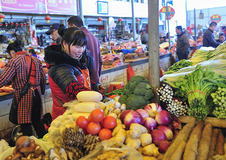A good harvest on the roof of the world
It's early spring in Yarlung Zangbo Gorge and the air is still chilly, as farmers from the Tadruk township in Tibet autonomous region's Nedong county prepare for the annual Spring Plowing Ceremony.
Today is March 16, which coincides with the eighth day of the second month of the Tibetan calendar, and the air is filled with the mixed fragrance of burning juniper branches and local barley wine.
Here in this valley, some 130 km away from the region's capital of Lhasa, stand the ancient palace of Yumbu Lakhar. In its shadow is a patch of farmland that tradition holds is the first cultivated field in the whole of Tibet.
Dressed in their best white scarves, or khadak, the farmers gather in this field - accompanied by the grand chanting of Buddhist monks and the scent of a roasted barley powder called tsamba being sprinkled in the air.
Soil is symbolically broken and barley wine offerings exchanged as the sounds and sights of ancient song and dance play across the valley.
This is a religious ritual that has been practiced by Tibetans for thousands of years, with the farmers gathering each spring to pray for a bumper harvest in the year ahead.
"Tibetans from all over the plateau come to pay homage to the farmland and the Yumbu Lakhar temple," said Kalzang Wangyal, a local villager.
"They take some soil with them and sprinkle it on their fields when they return home."
It is believed that this sacred soil from Tibet's first field will bring good luck, the 49-year-old said, and indeed more than 100 households in Tadruk were favored by fortune four years ago when a successful barley wine company moved into town.

"Ever since parts of my fields were rented by Tianyoude, the barley wine company, my annual income generated from those fields has doubled," said Kalzang Wangyal.
Traditionally, most Tibetans used domesticated yaks or cattle-yak to plow their fields, but recent advances have helped boost production and further improved the farmers' lot.
"Seven years ago we adopted modern machinery instead of yaks, and thanks to this technology, our work is not so hard and the production yield has increased," said Kalzang Dorje, another male villager.
More free time also means the villagers can now spend longer playing sports, as well as taking part in religious practices and other activities, the 62-year-old said.
Over the past five years, the local government of Tibet has invested 78.7 billion yuan ($12.2 billion) in farming and stock breeding, according to the region's 12th Five-Year Plan.
The latest official figures show annual grain output exceeded 1 million metric tons for the first time last year, up from 920,000 tons in 2010, while the per capita disposable income of rural residents increased by 13 percent.
What's more, according to the region's 13th Five-Year Plan (2016-20), 590,000 of Tibet's rural residents will be lifted out of poverty over the coming five years.
Your Comment
Name E-mailRelated News
-
;
-
-

-
Tibet saw grain and vegetable harvests in 2015
According the most recent data from the Farming and Animal Husbandry Office of Tibet, it was observed that in 2015 Tibet’s grain yield broke through 1 mln tons.
-
-
-

-
Tibet saw grain and vegetable harvests in 2015
Photo shows barley field in the Panam County of Tibet on August 3rd.
-
-
-

-
Tibet saw grain and vegetable harvests in 2015
Photo shows two yaks cultivate in the Rinpung County of Tibet on October 27th.According the most recent data from the Farming and Animal Husbandry Office of Tibet.
-
Based in Lhasa, Tibet Vista is a Tibet travel agency that specialized in Tibet permit, and Tibet tours for both private and group travelers at a local price!
•4 Days Lhasa City Group Tour from USD 460 •8 Days Everest Base Camp Group Tour from USD 850 •15 Days Mt.Kailash Group Tour from USD 1780 •2016 Tibet Train Tours from Beijing, Shanghai, Chengdu, Xining,etc










